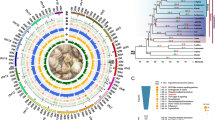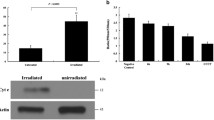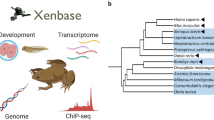Abstract
Hydra is a member of the ancient metazoan phylum Cnidaria and is an especially well investigated model organism for questions of the evolutionary origin of metazoan processes. Apoptosis in Hydra is important for the regulation of cellular homeostasis under different conditions of nutrient supply. The molecular mechanisms leading to apoptosis in Hydra are surprisingly extensive and comparable to those in mammals. Genome wide sequence analysis has revealed the presence of large caspase and Bcl-2 families, the apoptotic protease activating factor (APAF-1), inhibitors of apoptotic proteases (IAPs) and components of a putative death receptor pathway. Regulation of apoptosis in Hydra may involve BH-3 only proteins and survival pathways, possibly including insulin signalling.





Similar content being viewed by others
References
Böttger A, David CN (2003) Evolution of Cell death: caspase mediated mechanisms in early metazoans; noncaspase mechanisms in single celled eukaryotes. In: Grimm S (ed) Genetics of apoptosis. BIOS Scientific Publishers Ltd, Oxford, pp 145–153
Gierer A, Berking S, Bode H et al (1972) Regeneration of hydra from reaggregated cells. Nat New Biol 239:98–101
Fowler SJ, Jose S, Zhang X, Deutzmann R, Sarras MP Jr, Boot-Handford RP (2000) Characterization of hydra type IV collagen. Type IV collagen is essential for head regeneration and its expression is up-regulated upon exposure to glucose. J Biol Chem 275:39589–39599
Sarras MP Jr, Yan L, Grens A et al (1994) Cloning and biological function of laminin in Hydra vulgaris. Dev Biol 164:312–324
Zhang X, Boot-Handford RP, Huxley-Jones J et al (2007) The collagens of hydra provide insight into the evolution of metazoan extracellular matrices. J Biol Chem 282:6792–6802
Alexopoulos H, Bottger A, Fischer S et al (2004) Evolution of gap junctions: the missing link? Curr Biol 14:R879–R880
Filshie BK, Flower NE (1977) Junctional structures in hydra. J Cell Sci 23:151–172
Hand AR, Gobel S (1972) The structural organization of the septate and gap junctions of Hydra. J Cell Biol 52:397–408
Campbell RD (1967) Tissue dynamics of steady state growth in Hydra littoralis. II. Patterns of tissue movement. J Morphol 121:19–28
David CN, Gierer A (1974) Cell cycle kinetics and development of Hydra attenuata. III. Nerve and nematocyte differentiation. J Cell Sci 16:359–375
David CN, Campbell RD (1972) Cell cycle kinetics and development of Hydra attenuata. I. Epithelial cells. J Cell Sci 11:557–568
Bode HR (1996) The interstitial cell lineage of hydra: a stem cell system that arose early in evolution. J Cell Sci 109:1155–1164
David CN, Murphy S (1977) Characterization of interstitial stem cells in hydra by cloning. Dev Biol 58:372–383
Bosch TCG, David CN (1987) Stem cells of Hydra magnipapillata can differentiate into somatic and germ line cells. Dev Biol 121:182–191
Otto JJ, Campbell RD (1977) Tissue economics of hydra: regulation of cell cycle, animal size and development by controlled feeding rates. J Cell Sci 28:117–132
Bosch TC, David CN (1984) Growth regulation in Hydra: relationship between epithelial cell cycle length and growth rate. Dev Biol 104:161–171
Cikala M, Wilm B, Hobmayer E, Böttger A, David CN (1999) Identification of caspases and apoptosis in the simple metazoan Hydra. Curr Biol 9:959–962
Böttger A, Alexandrova O (2007) Programmed cell death in Hydra. Semin Cancer Biol 17:134–146
Abrams JM, White K, Fessler LI, Steller H (1993) Programmed cell death during Drosophila embryogenesis. Development 117:29–43
Mpoke SS, Wolfe J (1997) Differential staining of apoptotic nuclei in living cells: application to macronuclear elimination in Tetrahymena. J Histochem Cytochem 45:675–683
Bosch TCG, David CN (1986) Immunocompetence in Hydra: epithelial cells recognize self-nonself and react against it. J Exp Zool 238:225–234
Kuznetsov SG, Bosch TC (2003) Self/nonself recognition in Cnidaria: contact to allogeneic tissue does not result in elimination of nonself cells in Hydra vulgaris. Zoology (Jena) 106:109–116
Fujisawa T, David CN (1984) Loss of differentiating nematocytes induced by regeneration and wound healing in Hydra. J Cell Sci 68:243–255
Yaross MS, Bode HR (1978) Regulation of interstitial cell differentiation in Hydra attenuata. IV. Nerve cell commitment in head regeneration is position-dependent. J Cell Sci 34:27–38
Yaross MS, Bode HR (1978) Regulation of interstitial cell differentiation in Hydra attenuata. V. Inability of regenerating head to support nematocyte differentiation. J Cell Sci 34:39–52
Chera S, Ghila L, Dobretz K et al (2009) Apoptotic cells provide an unexpected source of Wnt3 signaling to drive hydra head regeneration. Dev Cell 17:279–289
Campbell RD (1976) Elimination by Hydra interstitial and nerve cells by means of colchicine. J Cell Sci 21:1–13
Fujisawa T, Sugiyama T (1978) Genetic analysis of developmental mechanisms in Hydra. IV. Characterization of a nematocyst-deficient strain. J Cell Sci 30:175–185
Marcum BA, Campbell RD (1978) Development of Hydra lacking nerve and interstitial cells. J Cell Sci 29:17–33
Aizenshtadt TB (1978) Oogenesis in Hydra. III. The growth and fusion of the oocytes. Ontogenez 9:115–123
Alexandrova O, Schade M, Böttger A, David CN (2005) Oogenesis in Hydra: nurse cells transfer cytoplasm directly to the growing oocyte. Dev Biol 281:91–101
Technau U, Miller MA, Bridge D, Steele RE (2003) Arrested apoptosis of nurse cells during Hydra oogenesis and embryogenesis. Dev Biol 260:191–206
Carrington PE, Sandu C, Wei Y et al (2006) The structure of FADD and its mode of interaction with procaspase-8. Mol Cell 22:599–610
Festjens N, Cornelis S, Lamkanfi M, Vandenabeele P (2006) Caspase-containing complexes in the regulation of cell death and inflammation. Biol Chem 387:1005–1016
Chowdhury I, Tharakan B, Bhat GK (2006) Current concepts in apoptosis: the physiological suicide program revisited. Cell Mol Biol Lett 11:506–525
Dempsey PW, Doyle SE, He JQ, Cheng G (2003) The signaling adaptors and pathways activated by TNF superfamily. Cytokine Growth Factor Rev 14:193–209
Giam M, Huang DC, Bouillet P (2008) BH3-only proteins and their roles in programmed cell death. Oncogene 27(Suppl 1):S128–S136
Vaux DL, Silke J (2005) IAPs, RINGs and ubiquitylation. Nat Rev Mol Cell Biol 6:287–297
Aouacheria A, Brunet F, Gouy M (2005) Phylogenomics of life-or-death switches in multicellular animals: Bcl-2, BH3-Only, and BNip families of apoptotic regulators. Mol Biol Evol 22:2395–2416
Wiens M, Diehl-Seifert B, Muller WE (2001) Sponge Bcl-2 homologous protein (BHP2-GC) confers distinct stress resistance to human HEK-293 cells. Cell Death Differ 8:887–898
Wiens M, Krasko A, Muller CI, Muller WE (2000) Molecular evolution of apoptotic pathways: cloning of key domains from sponges (Bcl-2 homology domains and death domains) and their phylogenetic relationships. J Mol Evol 50:520–531
Wang C, Youle RJ (2009) The role of mitochondria in apoptosis. Annu Rev Genet
Geng X, Shi Y, Nakagawa A et al (2008) Inhibition of CED-3 zymogen activation and apoptosis in Caenorhabditis elegans by caspase homolog CSP-3. Nat Struct Mol Biol 15:1094–1101
Silke J, Vaux DL (2001) Two kinds of BIR-containing protein—inhibitors of apoptosis, or required for mitosis. J Cell Sci 114:1821–1827
Lin N, Zhang C, Pang J, Zhou L (2009) By design or by chance: cell death during Drosophila embryogenesis. Apoptosis 14:935–942
Igaki T, Kanda H, Yamamoto-Goto Y et al (2002) Eiger, a TNF superfamily ligand that triggers the Drosophila JNK pathway. EMBO J 21:3009–3018
Kanda H, Igaki T, Kanuka H, Yagi T, Miura M (2002) Wengen, a member of the Drosophila tumor necrosis factor receptor superfamily, is required for Eiger signaling. J Biol Chem 277:28372–28375
Kauppila S, Maaty WS, Chen P et al (2003) Eiger and its receptor, Wengen, comprise a TNF-like system in Drosophila. Oncogene 22:4860–4867
Taylor RC, Cullen SP, Martin SJ (2008) Apoptosis: controlled demolition at the cellular level. Nat Rev Mol Cell Biol 9:231–241
Chowdhury I, Tharakan B, Bhat GK (2008) Caspases—an update. Comp Biochem Physiol B Biochem Mol Biol 151:10–27
Dunn SR, Phillips WS, Spatafora JW, Green DR, Weis VM (2006) Highly conserved caspase and Bcl-2 homologues from the sea anemone Aiptasia pallida: lower metazoans as models for the study of apoptosis evolution. J Mol Evol 63:95–107
Zmasek CM, Zhang Q, Ye Y, Godzik A (2007) Surprising complexity of the ancestral apoptosis network. Genome Biol 8:R226
Lasi M (2009) Das komplexe Netzwerk Apoptose regulierender Proteine in Hydra. Dissertation, Ludwig-Maximilians-University Munich
Yu X, Acehan D, Menetret JF et al (2005) A structure of the human apoptosome at 12.8. A resolution provides insights into this cell death platform. Structure 13:1725–1735
Acehan D, Jiang X, Morgan DG, Heuser JE, Wang X, Akey CW (2002) Three-dimensional structure of the apoptosome: implications for assembly, procaspase-9 binding, and activation. Mol Cell 9:423–432
Shaham S (1998) Identification of multiple Caenorhabditis elegans caspases and their potential roles in proteolytic cascades. J Biol Chem 273:35109–35117
Müller-Taubenberger A, Vos MJ, Böttger A et al. (2006) Monomeric red fluorescent protein variants used for imaging studies in different species. Eur J Cell Biol
Conradt B, Horvitz HR (1998) The C. elegans protein EGL-1 is required for programmed cell death and interacts with the Bcl-2-like protein CED-9. Cell 93:519–529
Schumacher B, Schertel C, Wittenburg N et al (2005) C. elegans ced-13 can promote apoptosis and is induced in response to DNA damage. Cell Death Differ 12:153–161
Edgar BA (2006) How flies get their size: genetics meets physiology. Nat Rev Genet 7:907–916
Burgering BM, Kops GJ (2002) Cell cycle and death control: long live Forkheads. Trends Biochem Sci 27:352–360
Puig O, Tjian R (2006) Nutrient availability and growth: regulation of insulin signaling by dFOXO/FOXO1. Cell Cycle 5:503–505
Steele R, Lieu P, Shenk M, Sarras M (1996) Response to insulin and the expression pattern of a gene encoding an insulin receptor homologue suggests a role for an insulin-like molecule in regulating growth and patterning in Hydra. Dev Genes Evol 206:247–259
Herold M, Cikala M, MacWilliams H, David CN, Böttger A (2002) Cloning and characterisation of PKB and PRK homologs from Hydra and the evolution of the protein kinase family. Dev Genes Evol 212:513–519
David CN, Schmidt N, Schade M, Pauly B, Alexandrova O, Böttger A (2005) Hydra and the evolution of apoptotis. Integr Comp Biol 45:631–638
Böttger A, Alexandrova O, Cikala M, Schade M, Herold M, David CN (2002) GFP expression in Hydra: lessons from the particle gun. Dev Genes Evol 212:302–305
Wittlieb J, Khalturin K, Lohmann JU, Anton-Erxleben F, Bosch TC (2006) Transgenic Hydra allow in vivo tracking of individual stem cells during morphogenesis. Proc Natl Acad Sci USA 103:6208–6211




